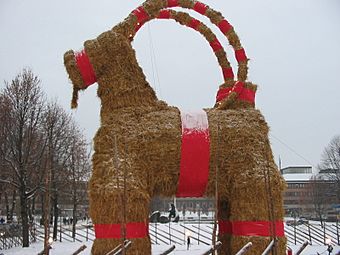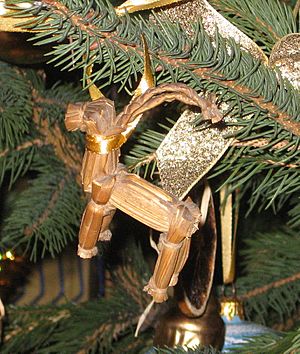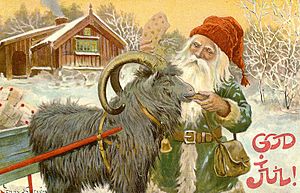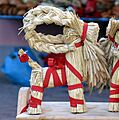Yule goat facts for kids
The Yule goat is a special symbol and tradition from Scandinavia and Northern Europe. It is part of the Yule and Christmas celebrations. Long ago, it was linked to ancient traditions. Today, Yule goats are usually made from straw.
Contents
History of the Yule Goat
The Yule goat has a very old history. Its roots go back to ancient festivals. One idea is that the goat is linked to the Norse god Thor. Thor was a powerful god who rode in a chariot. This chariot was pulled by two goats named Tanngrisnir and Tanngnjóstr.
People also believed the last bundle of grain harvested had magic. They called this bundle the Yule goat (Julbocken). It was saved for the winter celebrations. This idea is similar to old beliefs in Slavic cultures. During the Koliada festival, people honored a god of the sun and harvest. This god was sometimes shown as a white goat. So, people would dress as goats and ask for gifts.
In Sweden, some people thought the Yule goat was an invisible spirit. This spirit would appear before Christmas. It would check if all the holiday preparations were done right.
Sometimes, objects made of straw or wood were called Yule goats. A fun old prank was to secretly place one of these goats in a neighbor's house. The family who found it then had to pass it on to another neighbor without them noticing!
The Yule goat's role has changed over time. In the 17th century, young people would dress up in costumes. They would go from house to house, singing and performing plays. This tradition was like wassailing in England. The Yule goat was often part of this group. It was sometimes a bit wild and would ask for gifts.
In the 1800s, the Yule goat became a Christmas gift-bringer in Scandinavia. One person in the family would dress up as the goat. This might be connected to Santa Claus and the medieval celebrations of Saint Nicholas. Later, the Yule goat was replaced by the jultomte (like Father Christmas or Santa Claus). This happened in the late 1800s and early 1900s. However, in Finland, Santa Claus is still called Joulupukki, which means "Yule goat."
The Modern Yule Goat

Today, the Yule goat is best known as a Christmas ornament in Nordic countries. This modern Yule goat is usually made of straw. It is often tied with red ribbons. You can find these decorative goats under or on a Christmas tree.
Some towns and cities build very large Yule goats. This tradition started with the famous Gävle goat in Sweden in the 1960s. These big goats are a popular sight during Christmas time.
Julebukking Tradition
Julebukking is another Scandinavian Christmas tradition. It happens between Christmas and New Year's Day. People called Julebukkers wear masks and costumes. They go from door to door in their neighborhood. The people who open their doors try to guess who is under the disguise.
In one version of Julebukking, people sing Christmas songs. After they sing, they often get candy as a reward. Another tradition is that at least one person from the visited house must join the Julebukkers. Then, they all go to the next house together.
This custom is a bit like modern-day Halloween trick-or-treating. Julebukkers often try to change their voices and body language. This makes it harder for people to guess who they are. It is common to offer the Julebukkers holiday treats and drinks. Once everyone knows who is who, and the food is eaten, the Julebukkers move on to the next home.
Popular Culture
The Christmas goat appears in many old Christmas songs. These songs date back to the late 1800s and early 1900s. At that time, the Santa Claus tradition was not yet fully common in Sweden. Some of these songs include Julbocken, Julpolska, and Raska fötter springa tripp, tripp, tripp.
Images for kids
-
Julbocken by John Bauer (1912)
See also
 In Spanish: Julbock para niños
In Spanish: Julbock para niños












